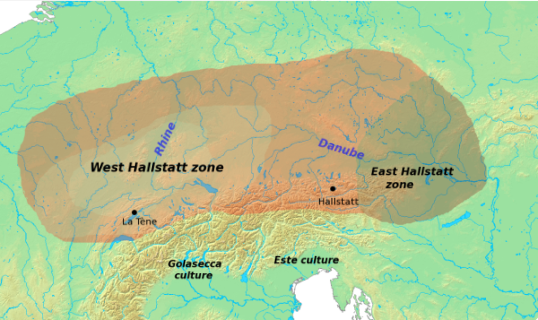julia90
Passione Mediterranea
- Messages
- 1,152
- Reaction score
- 65
- Points
- 48
- Location
- Florence-Lucca
- Ethnic group
- Tuscan-Italian-(European)
- mtDNA haplogroup
- H5b
It had been known for some time that there was an early, although apparently somewhat limited, Celtic (Lepontic, sometimes called Cisalpine Celtic) presence in Northern Italy since inscriptions dated to the 6th century BC have been found there.
The site of Golasecca, where the Ticino exits from Lake Maggiore, was particularly suitable for long-distance exchanges, in which Golaseccans acted as intermediaries between Etruscans and the Halstatt culture of Austria, supported on the all-important trade in salt.
In 391 BC Celts "who had their homes beyond the Alps streamed through the passes in great strength and seized the territory that lay between the Appennine mountains and the Alps" according to Diodorus Siculus. The Po Valley and the rest of northern Italy (known to the Romans as Cisalpine Gaul) was inhabited by Celtic-speakers who founded cities such as Milan. Later the Roman army was routed at the battle of Allia and Rome was sacked in 390 BC by the Senones.
At the battle of Telamon in 225 BC a large Celtic army was trapped between two Roman forces and crushed.
The defeat of the combined Samnite, Celtic and Etruscan alliance by the Romans in the Third Samnite War sounded the beginning of the end of the Celtic domination in mainland Europe, but it was not until 192 BC that the Roman armies conquered the last remaining independent Celtic kingdoms in Italy.
The site of Golasecca, where the Ticino exits from Lake Maggiore, was particularly suitable for long-distance exchanges, in which Golaseccans acted as intermediaries between Etruscans and the Halstatt culture of Austria, supported on the all-important trade in salt.
In 391 BC Celts "who had their homes beyond the Alps streamed through the passes in great strength and seized the territory that lay between the Appennine mountains and the Alps" according to Diodorus Siculus. The Po Valley and the rest of northern Italy (known to the Romans as Cisalpine Gaul) was inhabited by Celtic-speakers who founded cities such as Milan. Later the Roman army was routed at the battle of Allia and Rome was sacked in 390 BC by the Senones.
At the battle of Telamon in 225 BC a large Celtic army was trapped between two Roman forces and crushed.
The defeat of the combined Samnite, Celtic and Etruscan alliance by the Romans in the Third Samnite War sounded the beginning of the end of the Celtic domination in mainland Europe, but it was not until 192 BC that the Roman armies conquered the last remaining independent Celtic kingdoms in Italy.


